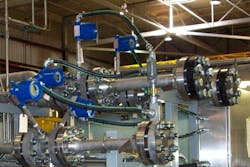Even though the earliest turbine flow meter was invented before positive displacement (PD) flow meters came into use, the history of turbine flow meter use does not go back as far as that of PD meters. PD meters were first used for gas applications in the early 1800s, while Reinhard Woltman invented the first turbine meter in 1790. Even so, it was not until the early 1940s that turbine meters were first used for fuel measurement, in part because fuel use on military planes in World War II needed to be measured. Soon afterward, turbine meters were used in the petroleum industry to measure the flow of hydrocarbons.
The history of using turbine meters to measure gas flow dates back to 1953. Rockwell introduced a turbine meter to the gas industry in 1963, but it took about 10 years for it to become widely accepted by the industry. In 1981 the American Gas Association (AGA) published its Report #7, "Measurement of Fuel Gas by Turbine Meters."
Suppliers Developing Better Performing Turbine Meters
Turbine meter suppliers are now developing features to make them more efficient and reliable. For example, new ceramic and sapphire ball bearings now last longer than other bearings. Another development is a dual-rotor turbine meter that extends the flow range and provides higher measurement accuracy, and also reduces the effects of swirl on flow measurement. Elster has developed a turbine meter that offers bi-directional flow.
Another research development, a new sensor design, will potentially reduce the pressure drop in turbine flow measurement. It could also provide enhanced accuracy and reduced susceptibility for particles in the flow stream. While this design is still in the development phase, it has the potential to impact the turbine meter market over time.
Industry Approvals
Approval organizations specify approvals for turbine meter use in custody transfer for utility measurement in residential, commercial and industrial applications. These organizations include AGA, the American Water Works Association and the International Standards Organization in Europe.
AGA’s approval of a standard for using turbine meters for natural gas custody transfer has increased their use. While turbine meters have enjoyed an advantage in the past based on their approvals, this advantage is diminishing as new-technology flow meters are approved for custody transfer of natural gas. Now turbine meters face competition from ultrasonic meters, and the report on the use of Coriolis flow meters has also been approved by AGA (Report #11).
Installed Base Gives Turbine Meters an Edge
One major growth factor for turbine flow meters is their large established base worldwide. Because they have been around longer than new-technology meters, they have had more time to penetrate the markets in Europe, North America and Asia, and when ordering flow meters, especially for replacement purposes, users often replace like with like. An investment in a flow meter technology includes not just the cost of the meter, but also training in its installation and use. Some companies stock spare parts or even spare meters for replacement purposes. This fuels the growth of the existing turbine meter market.
For more information about Flow Research’s work on turbine meters, visit www.flowturbine.com. Jesse Yoder, Ph.D., is president of Flow Research Inc. in Wakefield, Massachusetts, a company he founded in 1998. He has 28 years of experience as an analyst and writer in instrumentation. He holds a U.S. patent on a dual-tube meter design and is the author of The Tao of Measurement, published by ISA. Dr. Yoder also founded the Flowmeter Recalibration Working Group, addressing the topic of recalibration frequency. He may be reached at [email protected].
About the Author
Jesse Yoder
Jesse Yoder, Ph.D., is president of Flow Research Inc. He has 30 years of experience as an analyst and writer in instrumentation. Yoder holds two U.S. patents on a dual-tube meter design and is the author of "The Tao of Measurement," published by ISA. He may be reached at [email protected]. Find more information on the latest study from Flow Research, "The World Market for Gas Flow Measurement, 4th Edition," at www.gasflows.com.
